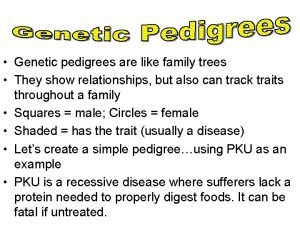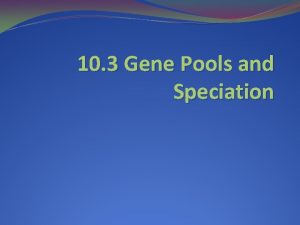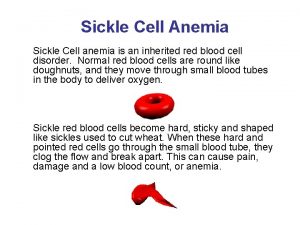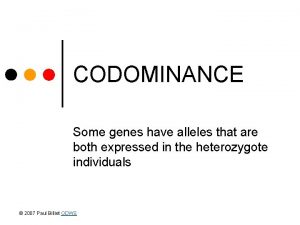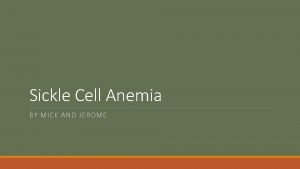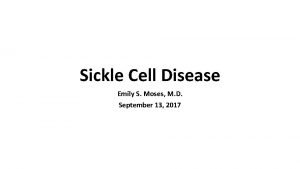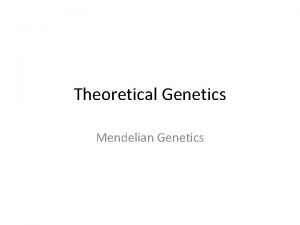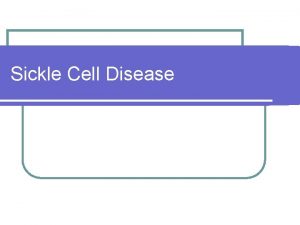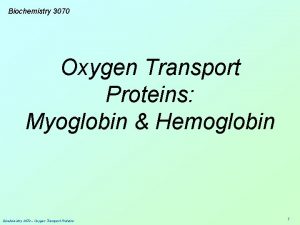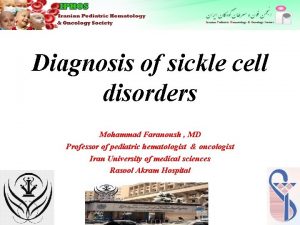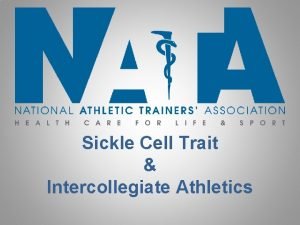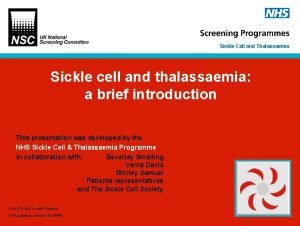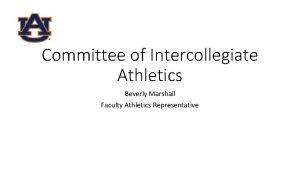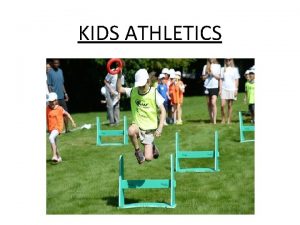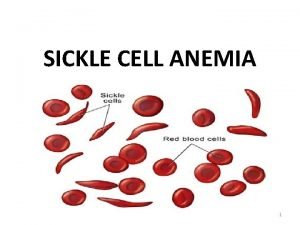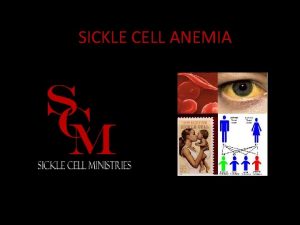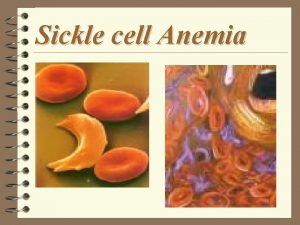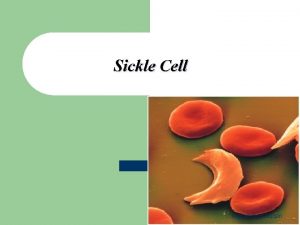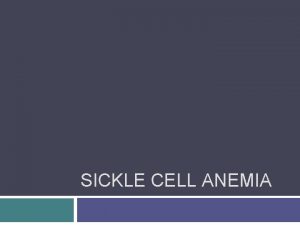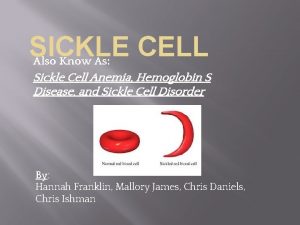Sickle Cell Trait Intercollegiate Athletics Sickle Cell Trait















- Slides: 15

Sickle Cell Trait & Intercollegiate Athletics

Sickle Cell Trait (Hereditary Condition) • Red blood cells (RBC’s) are normally round, circular or disc shaped. • RBC’s have hemoglobin component (helps carry oxygen) and platelets (helps in clotting) • Person gets one gene for “sickling” hemoglobin and one gene for normal hemoglobin. • People with sickle cell trait rarely have symptoms – because they have normal hemoglobin along with abnormal hemoglobin • With INTENSE or EXTENSIVE exercise the hemoglobin can take a sickle shape or crescent shape. • This effects oxygen carrying capacity to the cells!

Sickle Cell Trait • 10 deaths reported in collegiate football alone from Sickle Cell since 2000 during performance enhancement/conditioning sessions! • 1 death reported due to exertional sickling in pre-season to a track student-athlete in 2010! • Approximately 8 -9% of African Americans have sickle cell trait! • Hispanic Americans estimated at 4% • Brazilians estimated at 2 -8%! • Most common among people whose ancestry come from Africa, the Middle East, the Mediterranean, Caribbean and India! • Sickle Cell Trait Does Not disqualify athletes from participation in intercollegiate athletics!

SICKLE CELL EVENT (CASCADE-LIKE) When athletes experience dehydration, infection and low oxygen supply – The fragile RBC’s assume a crescent shape causing RBC breakdown, poor flow of RBC’s through blood vessels with poor oxygenation to the tissues!

SICKLE CELL EVENT cont. • The “Sickling of the RBC’s creates a “Log or Traffic Jam” which now results in: • Ischemic Rhabdomyolysis in which broken down muscle cells get released into the bloodstream as well! • Can occur in 2 -3 minutes of intense exertional exercise! • High Intensity with Repetitions is what triggers the “sickling event” and ultimately leads to a life-threatening crisis! • TRUE MEDICAL EMERGENCY as Kidney and Heart failure can or will result!

SICKLING vs HEAT Illness SICKLING HEAT ILLNESS Muscle pain and weakness of immediate onset similar to cramping but no visible or palpable spasm. Usually gradual onset after long practice in the heat. Athlete “slumps to a stop” and cannot hold themselves up. Cramping is visible and palpable. Usually occurs with intense work out! Temperature & Humidity not always a factor! Often occurs in the first 2 -5 days of training. Unlike cardiac arrest – athlete can still talk when on the ground. Can occur in even a well hydrated athlete! Altitude can have an impact. Cramping athlete “hobbles to a stop!” Core Temperature is elevated. Level of consciousness is altered during heat exhaustion and heat stroke. Usually have profuse sweating and weight loss. Temperature and Humidity are always a factor. Altitude is not a factor

SICKLE CELL NCAA requires Division 1 student athletes new to their campus to complete a sickle cell solubility test, show results of a prior test, or sign a written release declining the test. Insert institutional policy here

Athletes with Sickle Cell Trait Insert list of current athletes and their sport who are SCT positive at your institution.

NATA CONSENSUS STATEMENT 1) Build up slowly in training with paced progressions, allowing longer periods of rest and recovery between repetitions. 2) Encourage participation in preseason strength and conditioning programs to enhance the preparedness of athletes for performance testing which should be sports-specific. Athletes with sickle cell trait should be excluded from participation in performance tests such as mile runs, serial sprints, etc. , as several deaths have occurred from participation in this setting. 3) Cessation of activity with onset of symptoms [muscle ‘cramping’, pain, swelling, weakness, tenderness; inability to "catch breath", fatigue]. 4) If sickle-trait athletes can set their own pace, they seem to do fine.

NATA CONSENSUS STATEMENT cont. 5) All athletes should participate in a year-round, periodized strength and conditioning program that is consistent with individual needs, goals, abilities and sport-specific demands. Athletes with sickle cell trait who perform repetitive high speed sprints and/or interval training that induces high levels of lactic acid should be allowed extended recovery between repetitions since this type of conditioning poses special risk to these athletes. 6) Ambient heat stress, dehydration, asthma, illness, and altitude predispose the athlete with sickle trait to an onset of crisis in physical exertion. a. Adjust work/rest cycles for environmental heat stress b. Emphasize hydration c. Control asthma d. No workout if an athlete with sickle trait is ill e. Watch closely the athlete with sickle cell trait who is new to altitude. Modify training and have supplemental oxygen available for competitions

NATA CONSENSUS STATEMENT cont. 7) Educate to create an environment that encourages athletes with sickle cell trait to report any symptoms immediately; any signs or symptoms such as fatigue, difficulty breathing, leg or low back pain, or leg or low back cramping in an athlete with sickle cell trait should be assumed to be sickling. 8) Conditions that can predispose those with sickle cell trait to experiencing a sickling episode include high altitude, recent illness, and dehydration. SCT athletes should be carefully monitored or have adjustments made with any of these conditions.

BACK PAIN • Sickle Cell Trait athletes who report cramping and back tightness with activity (especially if it is early in exercise routine) should be immediately removed and monitored. • Back tightness with exertion – assume sickling unless proven otherwise. • - Does it occur often and subside with rest? • - No long lasting back pain? • - Burning type pain? THINK ISCHEMIA

ACUTE CARE & MANAGEMENT 1) 2) Check vital signs. Administer high-flow oxygen, 15 lpm (if available), with a nonrebreather face mask. 3) Cool the athlete, if necessary. 4) If the athlete is obtunded or as vital signs decline, call 911, attach an AED, start an IV, and get the athlete to the hospital fast. 5) Tell the doctors to expect explosive rhabdomyolysis and grave metabolic complications. 6) Proactively prepare by having an Emergency Action Plan and appropriate emergency equipment for all practices and competitions.

What we don’t want to happen! College/University In The News! “Insert Your College” Student Athlete’s Dies The Medical Examiners Office stated after examination of the body, a review of medical records, toxicology analysis and numerous other tests performed, that (INSERT NAME) death was the result of “dysrhythmia due to acute exertional rhabdomyolysis with sickle cell trait. ”

RESOURCES • • NATA Consensus Statement: Sickle Cell Trait and the Athlete NCAA Sports Medicine Handbook 2011 -2012: The Student-Athlete with Sickle Cell Trait. Center for Disease Control: www. cdc. gov/ncbddd/sicklecell/traits “Sickle Cell Trait and Exertional Rhabdomylosis” by Michelle Cleary, Athletic Therapy Today, 2003 “Fatal Rhabdomyolysis in a College Athlete Due to Sickle Cell Trait” by Rajesh I. Harrykissoon, MD, Bela Patel, MD, Mark T. Warner, MD and Rosa Estrada-Y-Martin, MD, American College of Chest Physicians, 2007. Sickle Cell Disease Association of America: www. sicklecelldisease. org/index. cfm? page=sicklecell-trait-athletics http: //www. nata. org/sites/default/files/Preventing-Sudden-Death-Position-Statement_2. pdf
 Intercollegiate football association
Intercollegiate football association You do athletics on a
You do athletics on a Sickle cell anemia pedigree
Sickle cell anemia pedigree Persilangan thalasemia
Persilangan thalasemia Sickle cell anemia
Sickle cell anemia Co hemoglobin
Co hemoglobin Is sickle cell anemia codominant
Is sickle cell anemia codominant Protein synthesis and mutations
Protein synthesis and mutations Inheritance pattern of sickle cell anemia
Inheritance pattern of sickle cell anemia Hemoglobin electrophoresis
Hemoglobin electrophoresis Sickle cell anemia genotype and phenotype
Sickle cell anemia genotype and phenotype Sickle cell anemia
Sickle cell anemia Sickle cell hemoglobin structure
Sickle cell hemoglobin structure Hemoglobin electrophoresis
Hemoglobin electrophoresis Nata sickle cell
Nata sickle cell Difference between sickle cell anaemia and thalassemia
Difference between sickle cell anaemia and thalassemia


